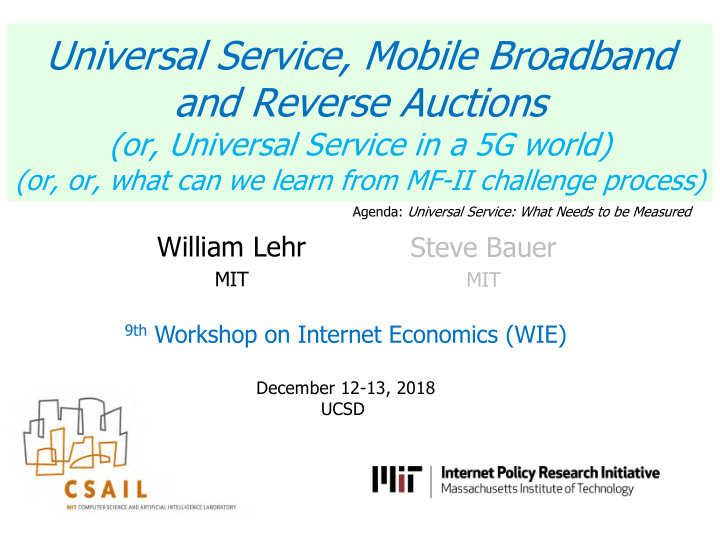



Universal Service, Mobile Broadband and Reverse Auctions (or, Universal Service in a 5G world) (or, or, what can we learn from MF-II challenge process) Agenda: Universal Service: What Needs to be Measured William Lehr Steve Bauer MIT MIT 9th Workshop on Internet Economics (WIE) December 12-13, 2018 UCSD
Rosenworcel: “FCC says 24million, while recent NYT article says 162million without adequate BB” USF in U.S.: $9B/year, $4.5B CAF, $0.5B MF-II Mobility Fund – Phase II (MF-II) : reverse auction for allocating USF funding Reverse auction: like an RFP with competitive bidding. Providers bid to meet service • requirements. Mobile: probability to deliver X Mbps Y% at network loading Z% at edge of 1 km grid • zone? (CAF: Fixed is to locations in area.) Step 1: Identify Eligible Areas? • (1) 477 Data: operator reported coverage by zones • (2) Challenge: submit measurements to ID white space • Proposal: Analyze MF-II Challenge Process and Data (1) Reverse auctions are economists’ preferred mechanism. How to improve • process? (2) Markets/Light-handed reg needs healthy measurement ecosystem which • requires capability for third parties (incl. independent analysts) to access basic broadband performance/service data (speed, latency, provider, etc.) for arbitrary locations/time/providers that combines mobile & fixed 2
Universal Service in a 5G World 5G: converged broadband – mobile/fixed, • tech-neutral regulation Lots of heterogeneity: tech, uses (bursty traffic), • Digital Divide Policy Problem value, costs Digital Divides always… markets evolve, tech • changes Where’s inflection point? Universal service – ensure access to BB • Available, Affordable, Accessible, (Adopted, • Equitable, Choice) Why not available? Not economically viable for • private investors. Solutions: Subsidize, Lower cost (other barriers), • Raise demand Challenges/research • questions/measurement need? Identify target BB goal: speed, services (latency), • affordability, usage Identify eligible subsidy areas (coverage goal) • Measure actual performance (better targeting, • impact assessment, enforcement) 3
Universal Service in 5G world (Q1) Goal: technology neutral reverse auction design (i.e., does not • differentiate between fixed and mobile proposals) Avoid distorting investment (arch, fixed/mobile), duplicative investment, tech- • neutral regulation (Q2) Data: USF needs • Identify territories eligible for subsidies (reverse auction) & challenge measurements • (to target funds, measure effectiveness) QoS impacts (how much speed matters? Balancing mobile v. fixed service • differences in performance, demand/supply) (Q3) Approach: look at MF-II process (and relation to CAF) • Evaluate challenge process, Implications of MF-II for investment • Does MF-II crowd-out/promote broadband investment in aggregate? • (Q4) Management: public data on performance measurement • Need integrated way to measure performance for BB (by location, time, tech, (use)) • What should be our Broadband USF goal: When (how) are Mobile and Fixed • substitutes or complements? 4
Some further questions Can we ever consolidate fixed and mobile measurements? • Fixed: by location, but no national dbase of locations geocoded and requires more • detailed infrastructure and subscriber location data that raises security, cost, and strategic confidentiality issues. Mobile: probabilistic by location, speed. Where are users in cell? What are they doing? • Are these really so different problems? • What level of precision needed? • Do we really need to serve 100%? At what cost to address last 1%? • What level of divergence between min and average is acceptable? • How many 9’s accuracy is reasonable? Where is inflection point? • How to aggregate data from different sources? • States/locals have more granular data, but not interoperable. • Voluntary data usually only provided with NDAs so hard to share. • Data layers: availability, usage, socio-economic demographics, pricing, costs • No economic impact assessment unless layering/aggregation feasible • Accuracy, sustainability challenges? • Measurement error? Misrepresentations? • Algebra of Measurement: how to composite measurements from different sources? • Incentives to measure, report truthfully, and share? • 5
Mobile Fund II support to advance LTE service in underserved areas Green: “1 unsubsidized provider” - challengable; Blue: no challenge, eligible for funding Challenge Process Timeline: ● Jan. 4, 2018: providers submitted one-time collection of 4G LTE coverage data ● Feb. 27, 2018: initial map of eligible areas released publicly ● Mar. 29, 2018 – Aug. 27, 2018: window to file challenges (“challenge window”) ● Sep. 2018: opportunity for challenged parties to view challenge data ● Oct. 2018 – Nov. 2018: window to file responses (“response window”)
7
Recommend
More recommend